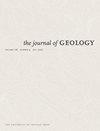巴西东北部borborrema省北部古元古代镁铁质-超镁铁质岩浆活动:构造背景与矿床潜力
IF 1.5
4区 地球科学
Q2 GEOLOGY
引用次数: 6
摘要
巴西东北部borborrema省里约热内卢Piranhas地体古元古代与弧相关的钙碱性深成岩中,镁铁质-超镁铁质侵入岩形成了一个32 km长的ne - sw向阵列。基性-超镁铁质侵入岩主要由辉长岩、斜辉长岩和滑石岩组成。它们的露头是细长的小体,由正长岩和混辉岩组成,并伴有少量角闪岩和表壳岩石。原生岩浆特征在侵入体的核心处占主导地位,而变质矿物和结构则是其外围带的特征。不同侵入体的积云橄榄石组成在Fo80.6 ~ Fo67.6 (Fo67.6)之间,为中等原始母岩浆。橄榄岩中积云斜长石与积云橄榄石共存的组成范围以高钙长石含量(an79.9 ~ an89.0)为特征。这一特征与岩浆岩间岩浆角闪洞一起,是与俯冲有关的岩浆弧中辉长岩侵入体的特征。U-Pb锆石年龄表明,镁铁质-超镁铁质侵入体在约2190±5 Ma时结晶。寄主正长石的U-Pb锆石年龄表明,它们在2220 ~ 2223 Ma的钙碱性长英质岩浆中结晶,因此仅为报道的长英质和镁质深部成矿事件提供了~ 30 Ma的锆石年龄。寄主岩石的U-Pb锆石年龄较老(2.47 Ga和2.69 Ga),表明较老的地壳成分与2.23 Ga钙碱性岩浆活动有关。地球化学数据和基性-超基性侵入体中变化的εNd(t)值表明,古地壳成分的存在与弧相关特征一致。拉斑岩和钙碱性岩浆作用与里约热内卢食人鱼地体研究中报道的约2.15-2.25 Ga岩浆弧有关。镁铁质-超镁铁质岩浆活动可能起源于岩浆弧,可能是造山后期俯冲带上方地幔楔块部分熔融的结果,为寻找镍铜铂族元素矿床提供了新的机会窗口。本文章由计算机程序翻译,如有差异,请以英文原文为准。
Paleoproterozoic Mafic-Ultramafic Magmatism in the Northern Borborema Province, Northeast Brazil: Tectonic Setting and Potential for Deposits
Mafic-ultramafic intrusions form a 32-km-long NE-SW-trending array within Paleoproterozoic arc-related calc-alkaline plutonic rocks of the Rio Piranhas terrane in the Borborema Province, Northeast Brazil. The mafic-ultramafic intrusions consist of wehrlite, clinopyroxenite, and troctolite. They outcrop as small elongated bodies hosted by orthogneiss and migmatites associated with minor amphibolite and supracrustal rocks. Primary magmatic features predominate in the core of the intrusions, whereas metamorphic minerals and textures characterize their outer zones. The composition of cumulus olivine from different intrusions ranges from Fo80.6 to Fo67.6 (forsterite), indicating moderately primitive parental magmas. The compositional range of cumulus plagioclase coexisting with cumulus olivine in troctolites is characterized by high anorthite content (An79.9–An89.0). This feature, together with interstitial magmatic amphibole in troctolites, is characteristic of gabbroic intrusions in subduction-related magmatic arcs. U-Pb zircon ages indicate that mafic-ultramafic intrusions crystallized at ca. 2190 ± 5 Ma. U-Pb zircon ages of host orthogneiss indicate that they crystallized from calc-alkaline felsic magmas at ca. 2220–2223 Ma, thus providing only ∼30 My for the reported events of felsic and mafic plutonism. U-Pb zircon ages of host rocks include older ages (2.47 and 2.69 Ga) indicating that older crustal components are associated with the 2.23 Ga calc-alkaline magmatism. The presence of older crustal components is consistent with arc-related features, indicated by geochemical data and variable εNd(t) values in the mafic-ultramafic intrusions. The tholeiitic and calc-alkaline magmatism is correlated with the ca. 2.15–2.25 Ga magmatic arc reported in previous studies of the Rio Piranhas terrane. The mafic-ultramafic magmatism is interpreted as having originated in a magmatic arc, possibly resulting from partial melting of a mantle wedge above the subduction zone in late stages of the orogeny and suggests a new window of opportunity for exploration of Ni-Cu–platinum group element deposits.
求助全文
通过发布文献求助,成功后即可免费获取论文全文。
去求助
来源期刊

Journal of Geology
地学-地质学
CiteScore
3.50
自引率
5.60%
发文量
0
审稿时长
3 months
期刊介绍:
One of the oldest journals in geology, The Journal of Geology has since 1893 promoted the systematic philosophical and fundamental study of geology.
The Journal publishes original research across a broad range of subfields in geology, including geophysics, geochemistry, sedimentology, geomorphology, petrology, plate tectonics, volcanology, structural geology, mineralogy, and planetary sciences. Many of its articles have wide appeal for geologists, present research of topical relevance, and offer new geological insights through the application of innovative approaches and methods.
 求助内容:
求助内容: 应助结果提醒方式:
应助结果提醒方式:


